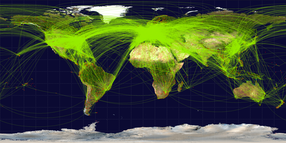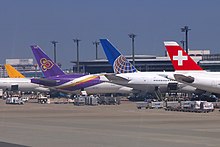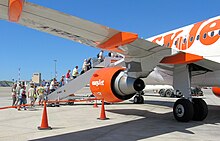Commercial aviation

Commercial aviationis the part ofcivil aviationthat involves operatingaircraftfor remuneration or hire, as opposed toprivate aviation.
Definition[edit]
Commercial aviation is not a rigorously defined category. Allcommercial air transportand aerial work operations are regarded as commercial aviation, as well as somegeneral aviationflights.
An aircraft operation involving the transportation of people, goods, or mail for payment or hiring is referred to as commercial air transport. Both scheduled and unscheduled air transport operations are included. An aircraft used for specialized services including agriculture, construction, photography, surveying, observation and patrol, search and rescue, advertising, etc. is referred to as aerial work.
[1]General aviation includes commercial activities such asflight instruction,aerial work, and corporate and business aviation, as well as non-commercial activities such as recreational flying.
Most commercial aviation activities require at minimum acommercial pilot licence,and some require anairline transport pilot licence(ATPL). In the US, thepilot in commandof a scheduled air carriers' aircraft must hold an ATPL.[2]In the UK, pilots must hold an ATPL before they be pilot in command of an aircraft with 9 or more passenger seats.[3]
Not all activities involving pilot remuneration require a commercial pilot licence. For example, inEuropean Union Aviation Safety Agencystates[4]and the UK[5]it is possible to become a paid flight instructor with only aprivate pilot licence.Nonetheless, in the UK, flight instruction is considered a commercial operation.[6]
It is the purpose of the flight, not the aircraft or pilot, that determines whether the flight is commercial or private.[7]For example, if a commercially licensed pilot flies a plane to visit a friend or attend a business meeting, this would be a private flight. Conversely, a private pilot could legally fly a multi-engine complex aircraft carrying passengers for non-commercial purposes (no compensation paid to the pilot, and apro rataor larger portion of the aircraft operating expenses paid by the pilot).
Potential radiation exposure[edit]
Themagnetosphereguidescosmic rayandsolar energetic particlesto polar latitudes, while high-energy charged particles enter themesosphere,stratosphere,andtroposphere.These energetic particles at the top of the atmosphere shatter atmospheric atoms and molecules, creating harmful lower-energy particles that penetrate deep into the atmosphere and create measurable radiation. All aircraft flying above 8 km (26,200 feet) altitude are exposed to these particles. The dose exposure is greater in polar regions than in mid-latitude and equatorial regions. When aspace weatherevent causes radiation exposure to exceed the safe level set by aviation authorities, the aircraft's flight path is diverted.[8]
While the most significant — but highly unlikely — health consequences of atmospheric radiation exposure include death fromradiation-induced cancerdue to long-term exposure, many lifestyle-degrading and career-impacting cancer forms can also occur.[9][10]A cancer diagnosis can have significant career impact for a commercial pilot. A cancer diagnosis can ground a pilot temporarily or permanently. International guidelines from theInternational Commission on Radiological Protection(ICRP) have been developed to mitigate this statistical risk.[11][12][13]The ICRP recommends effective dose limits of a 5-year average of 20mSvper year with no more than 50 mSv in a single year for nonpregnant, occupationally exposed persons, and 1 mSv per year for the general public. Radiation dose limits are not engineering limits. In the U.S., they are treated as an upper limit of acceptability and not a regulatory limit.[14]
Measurement of radiation at altitudes above 8 km (26,000 ft) has historically been done by instruments that record the data on board where the data are then processed later on the ground. However, a system of real-time radiation measurement has been developed through the NASA Automated Radiation Measurements for Aerospace Safety (ARMAS) program.[15]ARMAShas flown hundreds of flights since 2013, mostly on research aircraft, and sent the data to the ground throughIridium satellitelinks. The goal is to assimilate this data into physics-based global radiation models, e.g., NASA's Nowcast of Atmospheric Ionizing Radiation System (NAIRAS), so as to provide the weather of the radiation environment rather than theclimatology.
History[edit]
The examples and perspective in this sectiondeal primarily with the United States and do not represent aworldwide viewof the subject.(December 2018) |
United States[edit]
Origins[edit]

Harry BrunoandJuan Trippewere early promoters of commercial aviation.
TheAir Commerce Act of 1926began to regularize commercial aviation by establishing standards, facilitation, and promotion. An Aeronautical Branch was established in theDepartment of CommercewithWilliam P. MacCracken Jr.as director. To promote commercial aviation, he toldtown fathersthat "Communities without airports would be communities without airmail."
Writing forCollier'sin 1929, he noted "Commercial aviation is the first industry inspired by hero-worship and built upon heros". He cited the promotion in South America byHerbert Darguein early 1927. After his 1927 trans-Atlantic flight,Charles Lindberghmade a tour of thecontiguous United States,paid for by theDaniel Guggenheim Foundation for the Promotion of Aeronautics.From that point, commercial aviation took off:
Roads were choked on Sundays, for weeks afterward, by motorists trying to get toLambert Field,Lindbergh's home port in Saint Louis, to buy their first air hop. Hundreds of thousands of you went aloft for the first time that summer.[16]

The Aeronautical Branch was charged with issuingcommercial pilot licenses,airworthiness certificates,and with investigatingair accidents.[17]
After 1945[edit]

After World War II, commercial aviation grew rapidly, using mostly ex-military aircraft to transport people and cargo. The experience used in designingheavy bomberssuch as theBoeing B-29 SuperfortressandAvro Lancastercould be used for designing heavy commercial aircraft. TheDouglas DC-3also made for easier and longer commercial flights. The first commercial jet airliner to fly was the Britishde Havilland DH.106 Comet.By 1952, the British state airlineBritish Overseas Airways Corporationhad introduced the Comet into scheduled service. While a technical achievement, the plane suffered a series of highly public failures, including the crashing ofBOAC Flight 781andSouth African Airways Flight 201.[18][19]By the time the problems were overcome, other jet airliner designs had already taken to the skies.
Latin America[edit]
Pre-war[edit]
Inspired by the major players such as theUnited States,theSoviet Union,Russia,Franceand Britain in the aviation industry[clarification needed].In the 1910s,BrazilandArgentinawere among the first Latin American countries to possess the instruments of aircraft that were not all locally made, yet the aircraft was locally congregated.[20]At that time, many individuals were interested to be pilots in Latin American countries, yet there were not sufficient resources and funding to support and promote the best interests of the aviation industry.[20]Amidst these obstacles, Argentina and theDominican Republicmade efforts in creating jet aviation rather than creating and using propeller planes.[21]In 1944, theChicago Convention on International Civil Aviationattended by all Latin American countries except Argentina drafted the clauses of aviation law.[22]The introduction of thejet fighterF-80by the US in 1945 pushed the Latin American countries even further away from development of aviation industry because it was simply expensive to recreate the sophisticated technology of F-80.[20]
Post-war[edit]
The Latin American Civil Aviation Commission (LACAC) was formed in December 1973 "intended to provide civil aviation authorities in the region with an adequate framework for cooperation and coordination of activities related to civil aviation".[23]In 1976, about seven percent of the world logged in the Latin American and Caribbean region.[22]This contributed to the increase of average annual rate of air traffic.[22]Subsequently, higher passenger load factor decided the profitability of these airlines.
According to C. Bogolasky, airline pooling agreements between Latin American airlines contributed to better financial performance of the airlines. The economic problems related to the "airline capacity regulation, regulation of non-scheduled operations, tariff enforcement, high operating costs, passenger and cargo rates."[22]
Corporate social responsibility[edit]
Corporate social responsibilitycomprises an umbrella of responsibilities of an organization towards its community, stakeholders and shareholders.[24]Organizations who are socially responsible fulfill theirtriple bottom lineobligations and dedicate efforts to minimize negative impact on stakeholders and shareholders.[24]According to "The Pyramid of Corporate Social Responsibility" by Archie B. Carroll, there are four steps of social responsibility. First, economic responsibility of an organization is to produce profit and maximize the growth of an organization. Second, legal responsibility of an organization is to be compliant with all the laws and regulations. Third, ethical responsibility of an organization to create and follow standards of right decision-making considering how it affects all the stakeholders. Fourth, philanthropic responsibility of an organization to help the community and stakeholders by "giving back".[24]The extent of fulfilling the four responsibilities defines thecorporate citizenshipof an organization.[24]
DeltaandLATAMAirlines were the only two airlines listed on theDow Jones Sustainability Index,[25][26]LATAMbeing the only airline company in the world to achieve 100% scores for efficiency, reliability and climate strategy in their corporate sustainability assessment.[25]LATAMpromotes their corporate citizenship in their 2016 Sustainability report.[27]LATAMis affiliated with 6 countries which are Argentina, Colombia, Brazil, Ecuador, Chile, and Peru.[27]LATAM accounts for 95% of South America's air traffic.
See also[edit]
- Airliner
- Flight level
- Direct flight
- Domestic flight
- Environmental impact of aviation(including effects on climate change)
- International flight
- Mainline
- Non-stop flight
- Private aviation
References[edit]
- ^"1. Definitions"(PDF).Annex 6, Operation of Aircraft Part I, International Commercial Air Transport – Aeroplanes(9 ed.). International Civil Aviation Organization (ICAO). July 2010. pp. 1, 3 and 5.ISBN9789292315368.Archived(PDF)from the original on 9 February 2020.Retrieved17 March2019.
- ^"14 CFR Part 121 Air Carrier Certification".Federal Aviation Administration.Archivedfrom the original on 2021-10-10.Retrieved2021-10-10.
- ^"The EASA ATPL".Speedbird103.Archivedfrom the original on 4 April 2015.Retrieved4 April2015.
- ^EASA Part FCL, Annex 1, Subpart J, Section 2, 915.FI (b)
- ^Air Navigation Order 2016, Schedule 8, Part 1, Chapter 1, Remuneration Condition.
- ^"Use of National Permit to Fly for flight instruction and self fly hire | Civil Aviation Authority".
- ^"FAR 1.1 General definitions, Commercial operator".Archivedfrom the original on 2021-09-24.Retrieved2021-10-11.
- ^FAA Advisory Circular 120-52, March 5, 1990, Radiation exposure of air carrier crew members
- ^Wilson, J.W., P. Goldhagen, V. Rafnsson, J.M. Clem, and G. De Angelis (2002), Overview of Atmospheric Ionizing Radiation (AIR) Research: SST-Present, COSPAR, Houston, TX.
- ^W. K., Tobiska, W. Atwell, P. Beck, E. Benton, K. Copeland, C. Dyer, B. Gersey, I. Getley, A. Hands, M. Holland, S. Hong, J. Hwang, B. Jones, K. Malone, M. M. Meier, C. Mertens, T. Phillips, K. Ryden, N. Schwadron, S. A. Wender, R. Wilkins, M. A. Xapsos, Advances in Atmospheric Radiation Measurements and Modeling Needed to Improve Air Safety, Space Weather, 13, 202–210 (2015).
- ^ICRP, 1991. 1990 Recommendations of the International Commission on Radiological Protection. ICRP Publication 60. Ann. ICRP 21 (1–3).
- ^ICRP, 2005. Low-dose Extrapolation of Radiation-related Cancer Risk. ICRP Publication 99. Ann. ICRP 35 (4).
- ^ICRP, 2007. The 2007 Recommendations of the International Commission on Radiologi-cal Protection. ICRP Publication 103. Ann. ICRP 37 (2–4).
- ^NCRP Report No. 116 – Limitation of Exposure to Ionizing Radiation, National Council on Radiation Protection and Measurements (1993)
- ^W. K., Tobiska, D. Bouwer, D. Smart, M. Shea, J. Bailey, L. Didkovsky, K. Judge, H. Garrett, W. Atwell, B. Gersey, R. Wilkins, D. Rice, R. Schunk, D. Bell, C. Mertens, X. Xu, M. Wiltberger, S. Wiley, E. Teets, B. Jones, S. Hong, K. Yoon, Global real-time dose measurements using the Automated Radiation Measurements for Aerospace Safety (ARMAS) system, Space Weather, 14, 1053–1080 (2016).
- ^McCracken, William P. Jr.;Courtney, W. B. (1929-12-21). "It's Hard to Get You Up: Selling aviation in America".Collier's.pp. 10–11.
- ^The First Federal Regulator for AviationArchived2017-10-03 at theWayback MachinefromFederal Aviation Administration
- ^"On This Day – 10 January – 1954: Comet jet crashes with 35 on board".BBC News.2008.RetrievedFebruary 15,2024.
- ^Whitney, Peter D. (April 10, 1954)."Comet Wreckage Found in Sea; 3 Americans Among 21 Victims".The New York Times.p. 1.RetrievedFebruary 15,2024.
- ^abcDe La Pedraja, Rene (2013).The Influence of Airpower upon History.University Press of Kentucky. pp. 145–176.
- ^"Post WWII Highlights in Latin America Aviation History".smithsonianeducation.org.Archivedfrom the original on 2008-07-03.Retrieved2020-03-26.
- ^abcdBogolasky, Jose C."Air Transport in Latin America: The Expanding Role of the Latin American Civil Aviation Commission".Journal of Air Law and Commerce.44:75–107.Archivedfrom the original on 2021-01-18.Retrieved2020-04-08.
- ^"Latin American Civil Aviation Commission (LACAC)".IBAS.Archivedfrom the original on 2020-11-23.Retrieved2020-03-26.
- ^abcdFerell; Fraedrich; Ferell (2018). "Chapter 2, Section 2".Business Ethics: Ethical Decision Making & Cases, 12th Edition.Cengage.ISBN978-1337614436.
- ^ab"LATAM Airlines Group is the leading airline in the Americas on the Dow Jones Sustainability 'World' Index as responsible investment reaches new heights".latam.Archivedfrom the original on 2020-04-08.Retrieved2020-04-02.
- ^"Delta named to 2016 Dow Jones Sustainability North America Index".Delta News Hub.Archivedfrom the original on 2020-04-08.Retrieved2020-04-02.
- ^ab"Corporate citizenship".latam.Archivedfrom the original on 2020-04-08.Retrieved2020-04-02.
